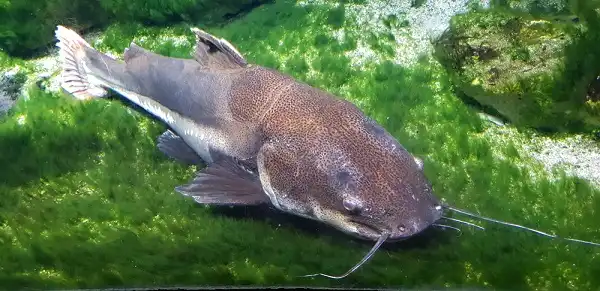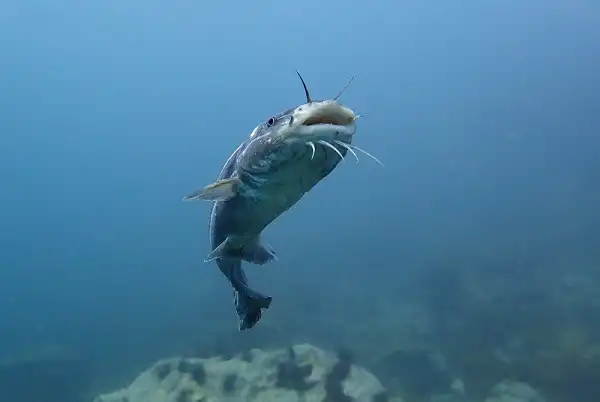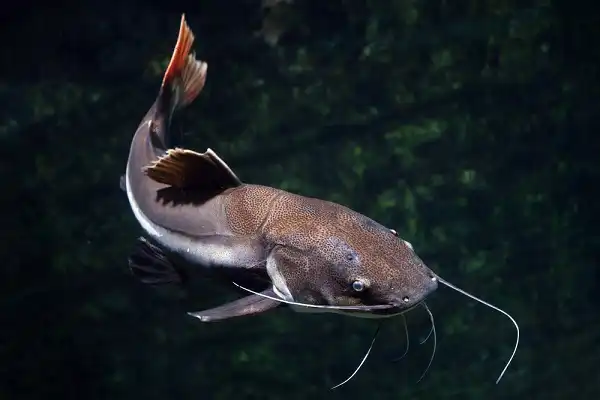Do you ever look down into the depths of a lake, pond, or river and wonder what lies beneath the surface? Have you ever heard stories of people coming face-to-face with some of the mysterious creatures inhabiting these waters? Creatures like catfish can reach sizes far beyond our wildest imaginations, making them an intriguing topic for discussion. This blog post aims to explore this captivating species in further detail by giving readers an up close and personal insight into catfish – their anatomy and behavior, habits, diet preference, as well as conservation efforts being taken on behalf of this incredible creature!

Catfish Description
The catfish is a large freshwater fish that belongs to the order Siluriformes. They are found in various habitats around the world, including rivers, lakes, and ponds. One of the most identifiable features of the catfish is their whisker-like barbels, which they use to locate food in the murky waters they inhabit. These barbels are lined with taste buds that help the catfish identify potential prey. In addition, the catfish has a flattened head and elongated body, which helps them move through the water with ease.
Catfish Habitat
Catfish are known to inhabit a wide range of habitats around the world, making them a highly adaptable species. Depending on the species, they can be found in freshwater, brackish water, and even some coastal areas. They are commonly found in rivers, lakes, ponds, and other bodies of water with slow-moving or stagnant currents. Catfish prefer to live in murky or muddy waters, where their camouflaged bodies help them evade predators while they search for food. They are bottom-dwelling creatures, spending most of their time near the riverbed or lake bottom. Some species, such as the flathead catfish, are known to prefer deeper waters, while others, like the channel catfish, can be found in shallow waters as well.
When it comes to temperature preferences, different species of catfish have varying tolerances. Some species can survive in colder waters, while others prefer warmer climates. For example, blue catfish are known to thrive in temperatures between 70-80°F, while channel catfish can survive in waters as cold as 45°F. Catfish are known to be highly adaptable to changes in their habitat, but they are still susceptible to environmental threats. Habitat destruction, water pollution, and overfishing are all factors that can impact catfish populations. Some species are more at risk of decline than others, such as the critically endangered Mekong giant catfish, which is threatened by dams and overfishing in its native habitat.
Catfish Diet
Catfish have a varied diet that depends on their specific species and habitat. They are opportunistic feeders that can consume anything from insects and crustaceans to small mammals and birds. The type of food they consume is largely determined by the availability of prey in their habitat. Young catfish typically feed on small invertebrates and zooplankton. As they grow, their diet expands to include larger prey such as insects, crayfish, and small fish. Some species, such as the blue catfish, are known to actively prey on other fish species including shad and sunfish.
Flathead catfish, on the other hand, tend to consume larger prey such as turtles and snakes. Catfish are bottom feeders and use their barbels, which are sensitive to taste and touch, to locate food. They are able to sense vibrations through the water and can detect even the slightest movements of potential prey. Once they find their target, they use their strong jaws and teeth to break apart their food before swallowing it whole. In order to maintain a healthy diet, catfish must consume a variety of prey in their habitat. Many species are able to adapt their diet to changes in prey availability, making them highly adaptable to fluctuations in their ecosystem.
Catfish Size
Catfish come in a variety of sizes, with the smallest species measuring just a few inches in length while the largest fish can grow up to several meters long. The Mekong giant catfish, for example, can reach lengths of up to 10 feet and weigh over 600 pounds. Such a large size can only be attained with good nutrition and a suitably large habitat. Generally, catfish are known for their impressive size and weight, with many species being considered trophy fish by anglers. The blue catfish, for instance, is known for its large size and can weigh over 100 pounds. In contrast, the channel catfish is typically smaller, averaging around 2-3 feet in length and weighing between 5-15 pounds. Catfish grow throughout their lives, but the rate of growth depends largely on environmental factors such as water temperature, food availability, and space. Good water quality and plenty of food can lead to rapid growth, while poor water quality and limited food can result in stunted growth or reduced survival rates. In some cases, catfish exhibit sexual dimorphism, with males being larger than females. This is true for some species, such as the flathead catfish, which can grow up to 5 feet in length and weigh over 100 pounds.

Catfish Lifespan
Catfish are well-known for their impressive size and opportunistic feeding habits which allow them to thrive in a variety of ecosystems. However, another noteworthy aspect of these fish is their lifespan. Interestingly, the lifespan of catfish can vary greatly depending on various factors, including species, environment, and genetics. Some species of catfish have been known to live for up to two decades, with some individual fish living even longer. For example, the blue catfish has been recorded to live for over 24 years in the wild. In contrast, other species such as the channel catfish typically have a shorter lifespan, averaging around 10-15 years. The lifespan of catfish is influenced by factors such as genetics and environmental conditions. In particular, water quality is a crucial factor that can greatly impact the health and longevity of catfish. Poor water quality, pollution, and fluctuating water temperatures can all contribute to stress and disease in catfish, reducing their lifespan. However, catfish can also adapt to their environment and may be capable of living longer than expected in certain circumstances. For example, catfish that are grown in farms or aquaculture settings may have fewer environmental stressors to contend with and may therefore live longer. In addition, some species of catfish, such as the flathead catfish, exhibit slow growth rates and may live longer as a result of reduced metabolic activity.
Catfish Behavior
Catfish behavior is fascinating and complex, with many interesting quirks and adaptations that have allowed them to survive and thrive in a wide variety of habitats. One notable behavior of catfish is their nocturnal feeding habits – many species are most active at night, scouring the riverbed for prey and using their sensitive barbels to detect food in low-light conditions. Another interesting aspect of catfish behavior is their ability to sense electrical currents in the water. Catfish have specialized organs called ampullae of Lorenzini that allow them to sense weak electrical fields, which they use to locate prey and navigate their environment. This can be especially useful in murky or low-light conditions, where visual cues are less reliable. In addition to their physical traits, catfish also have interesting social behavior. Some species, such as the channel catfish, form schools or shoals to migrate and forage together. Others are highly territorial and will defend their spawning grounds or feeding areas aggressively against rivals or intruders.
Catfish Speed
Catfish may not be known for their speed, but they are capable of swimming relatively fast. The average swimming speed of catfish varies depending on the species, size, and environmental factors. However, some species of catfish, such as the flathead catfish, can swim at speeds of up to 25 miles per hour. This impressive speed allows them to catch prey and escape predators quickly, making them highly successful and adaptable fish in their habitats. Moreover, catfish are incredibly efficient swimmers due to their streamlined body shape and powerful muscles. Their entire body is designed to maximize speed and minimize drag, allowing them to swim through the water with minimal effort. Additionally, their unique skin texture is covered in mucus, which reduces friction and allows them to accelerate and maneuver more smoothly. Another interesting fact about catfish speed is that they can change their swimming speed very quickly. They can go from a resting phase to a high-speed burst in seconds, which aids them in evading predators or capturing prey. When threatened, catfish can escape quickly by using their caudal fin, or tail, to thrust themselves forward and away from danger.

Catfish Hunting
Catfish hunting is a fascinating subject that sheds light on the predatory behavior of these aquatic creatures. Catfish are opportunistic predators that hunt a variety of prey in their natural habitat. They use a combination of sensory information, including their keen sense of smell and their ability to sense electrical fields, to locate prey. Once a potential meal has been detected, catfish will use their powerful muscles to quickly accelerate toward their target. Larger species of catfish, such as the flathead catfish, are capable of exerting tremendous force and can easily overpower smaller prey. One interesting aspect of catfish hunting behavior is their use of ambush tactics. Catfish will often lie in wait in areas where prey is likely to pass, such as near submerged structures or along the shoreline. When prey comes into range, the catfish will launch a lightning-fast attack, seizing its victim with its sharp teeth and powerful jaws. In addition to ambush tactics, catfish may also pursue their prey actively, as in the case of fast-swimming fish or aquatic invertebrates. They are skilled at adapting their hunting strategy to suit the particular prey they are targeting. For example, some species of catfish will use their barbels, specialized sensory organs on their face, to detect the movements of bottom-dwelling prey.
Catfish Types
Catfish come in a variety of shapes and sizes, with over 3000 different species inhabiting the world’s waterways. These fish have distinct features that set them apart from other types of fish, such as their skin texture, barbels on their face for sensing prey and predators, and flat heads. The two most common catfish types are the channel catfish (Ictalurus punctatus) and the blue catfish (Ictalurus furcatus). Channel catfish are characterized by an olive-brownish coloring, white belly, black spots along their sides, and three anal fin spines. Other catfish species include the flathead catfish (Pylodictis olivaris), which is a large, aggressive predator found in rivers and lakes; the bullhead catfish (Ameiurus melas), with its small size and dark brown coloration; and the wels catfish (Silurus glanis), which is an ancient species found in Europe’s waterways since ancient times.
Catfish Fishing Techniques
Catfish is a challenging and rewarding species to fish for. Depending on the type of catfish, anglers must be prepared with specific gear, bait, and techniques in order to be successful. For smaller-sized catfish such as bullhead or channel catfish, using worms on a hook is a good option. When targeting larger fish such as flathead or blue cats, live bait is often more effective. Popular baits include minnows, shad, nightcrawlers, gizzard shad, herring chunks, and chicken livers. In addition to selecting the right bait, it’s important to use the correct tackle when fishing for catfish as well. Heavier spinning rods with monofilament lines are best for most catfish species. Hook size and strength will vary depending on the type of fish being targeted, but 1/0 to 6/0 hooks are a safe bet. Knowing the right techniques, bait, and gear is essential when targeting catfish. By understanding their habits and behavior, anglers can increase their chances of success when fishing for these remarkable creatures.

Conclusion
Catfish are incredibly fascinating and adaptable creatures. Their powerful muscles, streamlined body shape, and unique skin texture enable them to swim with impressive speed and agility. Additionally, their keen sense of smell, ability to detect electrical fields, and ambush tactics make them highly successful predators in their habitats. Understanding the various aspects of catfish biology is key to preserving these species for generations to come. By gaining knowledge about catfish speed, hunting behavior, and environmental factors we can ensure that these remarkable creatures will continue to thrive in their natural habitats for years to come. The importance of protecting catfish populations cannot be understated — they play an integral role in aquatic ecosystems worldwide.
Frequently Asked Question

